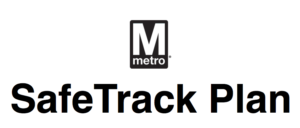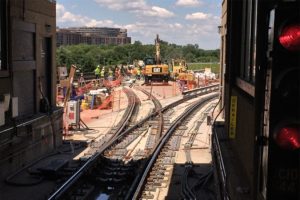(Updated at 4:35 p.m.) Metro has released its final version of the SafeTrack plan, beginning with work between the East Falls Church and Ballston stations.
This morning Metro General Manager Paul Wiedefeld outlined the agency’s plan for working through Metrorail’s deferred maintenance backlog.
The “safety surge,” dubbed SafeTrack, “accomplishes in one year, work that otherwise would take about three years to complete.” It comes at a time when major Metro track problems and electrical fires seem to be increasingly commonplace.
The plan involves fifteen long-duration track outages between June 4 and May 8, 2017, to allow for extensive track work.
The goal: to achieve “safety and state of good repair of basic track structure.”
So what can Arlington riders expect? First, there will be a moratorium on early system openings and closings — the system will close at midnight, seven day a week.
Additionally, the following track outages are planned.
 July 5-12
July 5-12
National Airport to Braddock Road
Impact: Entire line segment shut down
Service Reduction: Trains running every 12 minutes at Virginia Blue and Yellow Line stations
July 12-19
National Airport to Pentagon City
Impact: Entire line segment shut down
Service Reduction: Trains running every 12 minutes at Virginia Blue and Yellow Line stations
Aug. 20-Sept. 6
Eastern Market to Minnesota Ave/Benning Road
Impact: Entire line segment shut down
Service Reductions: Three lines affected. Orange and Silver lines running every 10 minutes, Blue Line running every 12 minutes.
Nov. 2-12
West Falls Church to East Falls Church
Impact: Continuous single tracking
Service Reduction: Trains on Orange and Silver lines each running every 16 minutes
Nov. 12-Dec. 5
East Falls Church to Ballston
Impact: Continuous single tracking
Service Reduction: Trains on Silver Line running every 18 minutes, Orange Line trains from Vienna to Ballston running every 18 minutes
Dec. 6-24
Pentagon to Rossyln
Impact: Entire line segment shut down, Arlington Cemetery station closed
Service Reduction: Reduced service at all Blue Line stations
March 6-14
West Falls Church to East Falls Church
Impact: Continuous single tracking
Service Reduction: Trains on Orange and Silver lines each running every 16 minutes
April 16-May 8
Braddock Road to Huntington/Van Dorn
Impact: Continuous single tracking
Service Reduction: Trains on Blue Line running every 18 minutes
In order to maximize productivity, all of the track outages will be continuous and will affect rush hour service. For the line segment shut downs, buses will replace trains around the station closures.
The safety surge will not only affect Metro riders, it’s expected to affect those who drive as well, in the form of additional traffic.
Metro's GM says road projects may have to adjust in areas when huge Metro projects are taking place. #wmata @nbcwashington
— Adam Tuss (@AdamTuss) May 6, 2016
Metro shutdown is so huge, traffic signals may have to be retimed to accommodate more drivers. #wmata
— Will Sommer (@willsommer) May 6, 2016
Here’s what Rep. Don Beyer (D-Va.) had to say about the plan.
My statement on the @wmata GM Wiedefeld's plan for #Metro safety overhaul: pic.twitter.com/CY0qadWgdx
— Rep. Don Beyer (@RepDonBeyer) May 6, 2016
After the jump, the full press release from Metro.
Metro General Manager/CEO Paul J. Wiedefeld today released SafeTrack, an expanded track work plan to improve Metrorail safety and restore service reliability.
Wiedefeld’s SafeTrack plan includes 15 “safety surges” over the next year that will accelerate maintenance on Metro’s rail system from the ballast up. By closing the system at midnight on weekends and expanding weekday maintenance opportunities, the plan addresses FTA and NTSB safety recommendations and deferred maintenance backlogs while restoring track infrastructure to good health.
SafeTrack accomplishes in one year, work that otherwise would take about three years to complete.
Fifteen “safety surges” are planned that will allow track crews to exponentially increase productivity and achieve safety results for customers faster. These long-duration track outages use either around-the-clock single tracking or line-segment shutdowns that will impact rush hour commutes. Metrorail riders will be encouraged to consider using alternate travel options while safety surge work is in effect on their line.
In addition, Wiedefeld announced a moratorium on early openings and late closings. Closure of the Metrorail system at midnight seven days a week will begin Friday, June 3.
“This plan is going to take some sacrifice from all of us,” Wiedefeld said. “But it is clear that the current approach is not working, more aggressive action is necessary.”
Following the review and consideration of traffic mitigation and alternate travel options by the Department of Transportation (DOT) agencies in the District of Columbia, Maryland and Virginia, regional law enforcement, Office of Personnel Management (OPM), Department of Homeland Security and General Services Administration (GSA), a final version of SafeTrack will be released for riders on May 16.
“Metro’s safety culture change depends on support from the entire region,” said Wiedefeld. “We have to begin by understanding that safety trumps inconvenience.”


